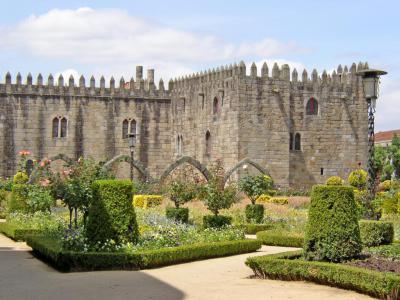
Episcopal Palace, Braga (must see)
The Episcopal Palace was once the residence of the archbishops of Braga, a position of great importance in the region's ecclesiastical hierarchy.
The origins of the Bishopric of Bracara date back to 388 when it was founded by Paternus, who became its first bishop. Officially, the archbishopric of Braga was established in 1071, with D. Pedro serving as its first archbishop. The political landscape in Braga evolved as well, with Count D. Henrique and Countess D. Teresa holding sway over the city between 1096 and 1112. In 1112, a significant letter was issued, donating the city to the archbishops and instituting an ecclesiastical fiefdom that would persist until the 18th century.
The Episcopal Palace comprises three distinct buildings, each representing different architectural styles: Gothic, Renaissance, and Baroque. These buildings are interconnected, resulting in an irregular and asymmetrical composition.
The medieval portion of the palace is associated with a rectangular garden patio that faces the Garden of Santa Bárbara. This section is characterized by its Gothic features. The 15th-century U-shaped wing connects to the medieval structure and is oriented toward the rectangular square known as Largo do Paço. The Baroque Wing, facing Largo do Município, represents the most formal and symmetrical section of the palace. It features a three-register structure with a recessed central body and lateral wings.
In 1911, the archbishop was expelled from the palace, leading to its occupation by the military and fire brigade. During the 1930s, the palace underwent renovations to transform it into a public library and archive. Today, it houses the Biblioteca Pública de Braga, local archives, and offices of the University of Minho.
The origins of the Bishopric of Bracara date back to 388 when it was founded by Paternus, who became its first bishop. Officially, the archbishopric of Braga was established in 1071, with D. Pedro serving as its first archbishop. The political landscape in Braga evolved as well, with Count D. Henrique and Countess D. Teresa holding sway over the city between 1096 and 1112. In 1112, a significant letter was issued, donating the city to the archbishops and instituting an ecclesiastical fiefdom that would persist until the 18th century.
The Episcopal Palace comprises three distinct buildings, each representing different architectural styles: Gothic, Renaissance, and Baroque. These buildings are interconnected, resulting in an irregular and asymmetrical composition.
The medieval portion of the palace is associated with a rectangular garden patio that faces the Garden of Santa Bárbara. This section is characterized by its Gothic features. The 15th-century U-shaped wing connects to the medieval structure and is oriented toward the rectangular square known as Largo do Paço. The Baroque Wing, facing Largo do Município, represents the most formal and symmetrical section of the palace. It features a three-register structure with a recessed central body and lateral wings.
In 1911, the archbishop was expelled from the palace, leading to its occupation by the military and fire brigade. During the 1930s, the palace underwent renovations to transform it into a public library and archive. Today, it houses the Biblioteca Pública de Braga, local archives, and offices of the University of Minho.
Want to visit this sight? Check out these Self-Guided Walking Tours in Braga. Alternatively, you can download the mobile app "GPSmyCity: Walks in 1K+ Cities" from Apple App Store or Google Play Store. The app turns your mobile device to a personal tour guide and it works offline, so no data plan is needed when traveling abroad.
Episcopal Palace on Map






Sight Name: Episcopal Palace
Sight Location: Braga, Portugal (See walking tours in Braga)
Sight Type: Attraction/Landmark
Guide(s) Containing This Sight:
Sight Location: Braga, Portugal (See walking tours in Braga)
Sight Type: Attraction/Landmark
Guide(s) Containing This Sight:
Walking Tours in Braga, Portugal
Create Your Own Walk in Braga
Creating your own self-guided walk in Braga is easy and fun. Choose the city attractions that you want to see and a walk route map will be created just for you. You can even set your hotel as the start point of the walk.
Braga Introduction Walking Tour
The history of Braga, Portugal's religious capital, spans millennia. Located in the northern Minho region, this city is also one of the country's oldest, reportedly founded by Bracari Celts.
Braga's origin is closely associated with the Roman conquest in 136 BC, culminating in the establishment of Bracara Augusta in 16 BC, a pivotal location within the newly-formed Gallaecia... view more
Tour Duration: 2 Hour(s)
Travel Distance: 2.0 Km or 1.2 Miles
Braga's origin is closely associated with the Roman conquest in 136 BC, culminating in the establishment of Bracara Augusta in 16 BC, a pivotal location within the newly-formed Gallaecia... view more
Tour Duration: 2 Hour(s)
Travel Distance: 2.0 Km or 1.2 Miles
Historical Religious Sites Walking Tour
Braga is a prominent destination in Portugal's Religious Tourism segment, primarily due to its vibrant Holy Week celebrations and rich ecclesiastical architecture. Indeed, being one of the world's oldest Christian cities, Braga boasts an extensive religious legacy. Much like Rome, it seamlessly interweaves art and spirituality throughout its historic center.
Here, you will find a... view more
Tour Duration: 1 Hour(s)
Travel Distance: 1.4 Km or 0.9 Miles
Here, you will find a... view more
Tour Duration: 1 Hour(s)
Travel Distance: 1.4 Km or 0.9 Miles


